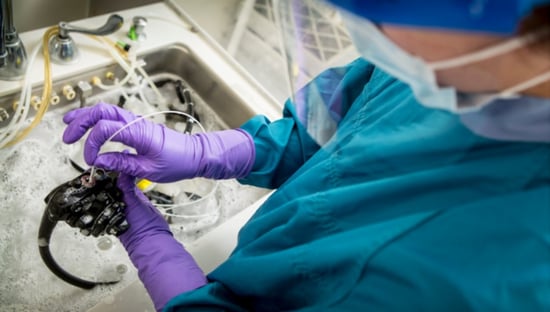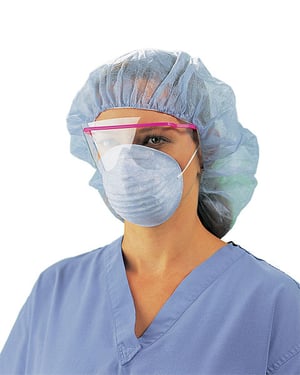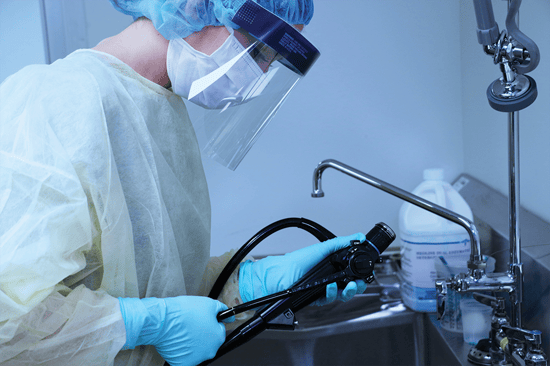Staying Safe During Scope Reprocessing
by Larissa Biggers, on August 16, 2019
The 2018 list of top 10 health technology hazards ranks the "failure to consistently and effectively reprocess flexible endoscopes" as #2. It may seem surprising, but when scopes are not thoroughly cleaned, dried, and stored, they can harbor Pseudomonas (associated with sepsis), salmonella, E. coli, and worse. These microorganisms can then be passed to patients undergoing an endoscopic procedure, like a colonoscopy, and to staff handling the scopes before, during, and after the case.
A complicated (re)process
Flexible endoscopes are made up multiple long, narrow channels; advanced electronics; fiber optics; and imaging technology. This complexity and fragility means that endoscopes typically cannot withstand steam sterilization. Rather, they require low temperature chemical disinfection or sterilization processes (reprocessing). The goal is not 100% sterilization but preventing the transmission of pathogens to patients.
Reprocessing is an eight-step process; and each step involves numerous tasks and sub-tasks. For instance, Step 3, Manual Cleaning, includes 13 multi-part tasks and six subtasks. Task 5 under Step 3 reads, "Use a small, soft brush to clean all removable parts, including inside and under the suction valve, air/water valve, and biopsy port cover and openings."

Although the Society of Gastroenterology Nurses and Associates (SGNA), the American Society for Gastrointestinal Endoscopy (ASGE), and the Association for Professionals in Infection Control and Epidemiology (APIC) established comprehensive standards to be followed for reprocessing, guidelines vary per manufacturer and oftentimes, facility. These discrepancies can make adhering to a consistent process even more challenging.
In addition to requiring a good memory and meticulous attention to detail, scope reprocessing is time consuming, physically demanding, and potentially dangerous. Endoscopy staff should be aware of the importance of each reprocessing step as well as the risks involved.
Biological threats
In the course of handling and disinfecting endoscopes, nurses and technicians are exposed body fluids, contaminated equipment, and potentially infectious material. Accordingly, they should wear appropriate personal protective equipment (PPE), for example, chemically resistant single-use gloves, protective eyewear, face masks, and long-sleeved, moisture-resistant protection gowns.
Toxins
Exposure to chemicals is another risk associated with scope reprocessing. Staff come into contact with not only liquid process chemicals but also drugs and potential allergens such as latex. In the event of splashing, an eyewash station with a separate sink should be available in the reprocessing room. In addition to the PPE mentioned above, staff should wear extended cuff gloves and full-face protection for the eyes, nose, and mouth.

Air-born hazards
Staff who reprocess endoscopes must have access to respiratory protective equipment (RPE) when handling chemicals, especially disinfectants containing respiratory sensitizers. Chlorine dioxide, for instance, is often used for reprocessing because it allows for fast disinfection. However, because it is an irritant to eyes and mucus membranes (including the respiratory tract), it requires exchange equipment (a ventilation system, exhaust hoods, etc.) and should be stored in a lidded container.
Ergonomic and physical risks
As mentioned, reprocessing is time-intensive, and staff maintain standing and bending postures for the duration. Over time, this puts them at risk for musculoskeletal disorders. As an added burden, they are often under pressure to complete reprocessing quickly. These requirements, along with the repetitive movements involved in transporting, scrubbing, and drying scopes result in a high rate of repetitive strain injuries (RSIs). Some GI units alternate staff mid-day or limit these duties to two or three days a week to prevent fatigue and injuries; other practices simply do not have enough staff to exercise these options.

Some GI suites use automated endoscope reprocessors (AERs) to replace some of the manual reprocessing steps, for example, leak testing and rinsing. Although they can lighten the workload for staff, they do not replace all manual cleaning tasks (e.g., washing and brushing channels). In addition, these units can be expensive and require focused training. And if an AER malfunctions, endoscopy staff must be adept at manual reprocessing, or procedures might have to be cancelled.
Steps for staying safe
There is no question that adequately reprocessing endoscopes is essential to ensuring patient safety. At the same time, staff need to be protected from the physical risks involved. Ideally, endoscopy units will:
- Establish and adhere to a health and safety policy.
- Conduct infection control rounds in high-risk areas to ensure that reprocessing instructions are accurate and are properly implemented.
- Provide appropriate equipment to protect staff from spills, chemicals, and body fluids.
- Conduct regular health checks for staff working with potentially sensitizing or allergy-inducing chemicals.
- Offer all staff appropriate vaccination against infectious agents.
While the FDA and other regulatory bodies focus on health risks to patients from improper reprocessing techniques, endoscopy units and hospitals must realize that this essential procedure puts staff at risk—and should do their best to protect them.


